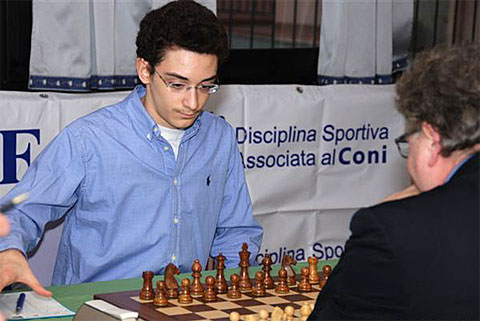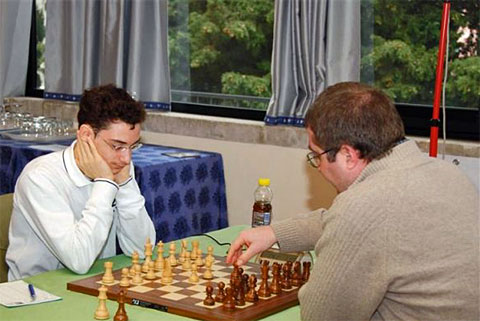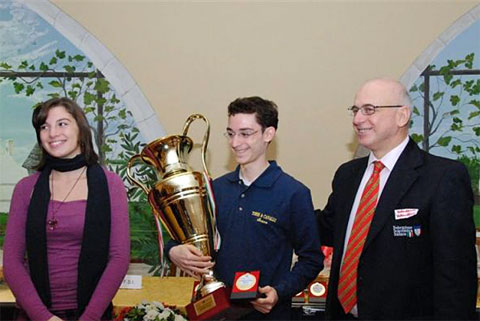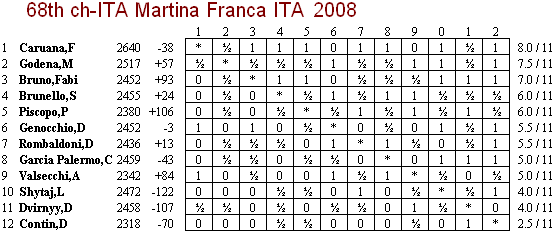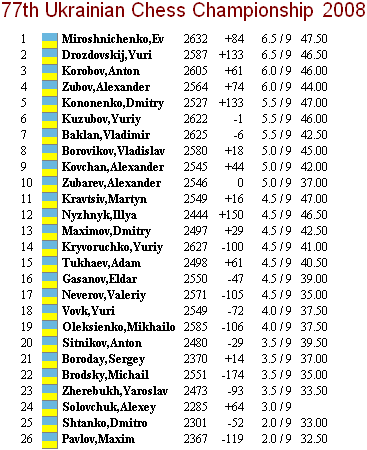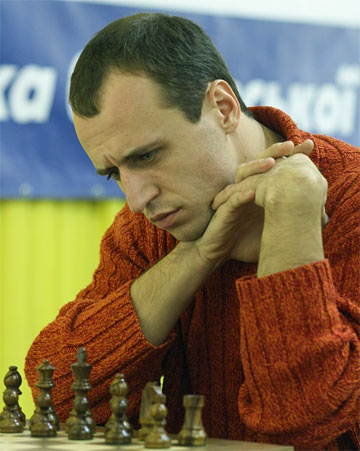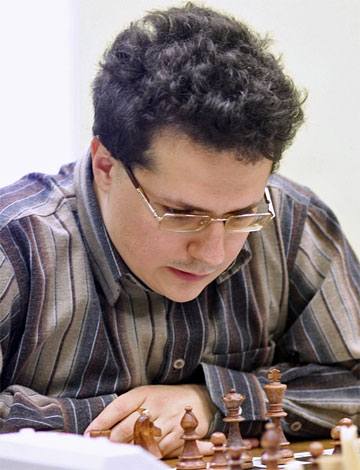Penang, 1974
1.e4 c5 2.Nf3 Nc6 3.d4 cxd4 4.Nxd4 Nf6 5.Nc3 d6 6.Bc4
The SOZIN ATTACK that was popularized by World Champion Fischer.
6 ... e6 7.Be3
[Site "Amsterdam (Netherlands)"][Date "1996"][Round "1"]
[White "Veselin Topalov"]
[Black "Garry Kasparov"]
[ECO "B90"]
1.e4 c5 2.Nf3 d6 3.d4 cxd4 4.Nxd4 Nf6 5.Nc3 a6 6.Bc4 e6 7.Bb3
Nbd7 8.f4 Nc5 9.O-O Ncxe4 10.Nxe4 Nxe4 11.f5 e5 12.Qh5 Qe7
13.Qf3 Nc5 14.Nc6 Qc7 15.Bd5 a5 16.Bg5 Ra6 17.Nd8 f6 18.Nf7
Rg8 19.Be3 g6 20.Ng5 Rg7 21.fxg6 Rxg6 22.Bf7+ Qxf7 23.Nxf7
Kxf7 24.Bxc5 dxc5 25.Rad1 Be7 26.Rd5 Bg4 27.Qe4 Kg7 28.Rfd1
Bxd1 29.Rxd1 Re6 30.Qf5 Kf7 31.Re1 b6 32.h4 Rg7 33.Kf1 Bd6
34.Kf2 Bc7 35.Kf3 Ke7 36.Re4 Kf7 37.Rg4 Re7 38.Ke4 Rxg4+
39.Qxg4 Bd8 40.a4 Kf8 41.c3 Rg7 42.Qc8 Ke8 43.Qe6+ Kf8 44.g4
Rf7 45.h5 Rg7 46.h6 Rg6 47.Qd5 Be7 48.Kf5 Rxh6 49.Qb7 e4
50.Qb8+ Kf7 51.Qxb6 e3 52.Qe6+ Ke8 53.Qxe3 Rg6 54.Qe4 Rg5+
55.Kf4 Kd7 56.Qb7+ Ke6 57.Qc8+ Kf7 58.Qc7 h5 59.gxh5 Rxh5
60.Qxa5 Bd6+ 61.Ke4 f5 62.Kd5 Be7 63.Qc7 Rh6 64.a5 Rd6+ 65.Ke5
Rf6 66.Qc8 1-0
[Event "Denver Candidates Match"][Date "1971"][Round "5"]
[White "Robert James Fischer"]
[Black "Bent Larsen"]
[ECO "B88"]
1. e4 c5 2. Nf3 d6 3. d4 cxd4 4. Nxd4 Nf6 5. Nc3 Nc6 6. Bc4 e6
7. Bb3 Be7 8. Be3 O-O 9. O-O Bd7 10. f4 Qc8 11. f5 Nxd4
12. Bxd4 exf5 13. Qd3 fxe4 14. Nxe4 Nxe4 15. Qxe4 Be6 16. Rf3
Qc6 17. Re1 Qxe4 18. Rxe4 d5 19. Rg3 g6 20. Bxd5 Bd6 21. Rxe6
Bxg3 22. Re7 Bd6 23. Rxb7 Rac8 24. c4 a5 25. Ra7 Bc7 26. g3
Rfe8 27. Kf1 Re7 28. Bf6 Re3 29. Bc3 h5 30. Ra6 Be5 31. Bd2
Rd3 32. Ke2 Rd4 33. Bc3 Rcxc4 34. Bxc4 Rxc4 35. Kd3 Rc5
36. Rxa5 Rxa5 37. Bxa5 Bxb2 38. a4 Kf8 39. Bc3 Bxc3 40. Kxc3
Ke7 41. Kd4 Kd6 42. a5 f6 43. a6 Kc6 44. a7 Kb7 45. Kd5 h4
46. Ke6 1-0
[Event "Denver m Rd: 3"][Date "1971"]
[White "Robert James Fischer"]
[Black "Bent Larsen"]
[ECO "B88"]
1. e4 c5 2. Nf3 d6 3. d4 cxd4 4. Nxd4 Nf6 5. Nc3 Nc6 6. Bc4 e6
7. Bb3 Be7 8. Be3 O-O 9. f4 Bd7 10. O-O a6 11. f5 Qc8 12. fxe6
Bxe6 13. Nxe6 fxe6 14. Na4 Rb8 15. Nb6 Qe8 16. Bxe6+ Kh8
17. Bf5 Ne5 18. Qd4 Qh5 19. Nd5 Nxd5 20. Qxd5 Qe2 21. Ba7 Rbe8
22. Rf2 Qb5 23. c3 Bh4 24. g3 Qxd5 25. exd5 Bf6 26. Raf1 Nc4
27. Be6 Ra8 28. Bd4 Bxd4 29. cxd4 Rxf2 30. Rxf2 b5 31. Kf1 g6
32. b3 Na3 33. Ke2 Ra7 34. Rf8+ Kg7 35. Rd8 b4 36. Rxd6 Nb5
37. Rb6 Nxd4+ 38. Kd3 Nxe6 39. Rxe6 a5 40. Kd4 Kf7 41. Re2 1-0
[Event "Palma de Mallorca iz Rd: 9"][Date "1970"]
[White "Robert James Fischer"]
[Black "Bent Larsen"]
[ECO "B88"]
1. e4 c5 2. Nf3 d6 3. d4 cxd4 4. Nxd4 Nf6 5. Nc3 Nc6 6. Bc4 e6
7. Bb3 Be7 8. Be3 O-O 9. Qe2 a6 10. O-O-O Qc7 11. g4 Nd7
12. h4 Nc5 13. g5 b5 14. f3 Bd7 15. Qg2 b4 16. Nce2 Nxb3+
17. axb3 a5 18. g6 fxg6 19. h5 Nxd4 20. Nxd4 g5 21. Bxg5 Bxg5+
22. Qxg5 h6 23. Qg4 Rf7 24. Rhg1 a4 25. bxa4 e5 26. Ne6 Qc4
27. b3 Qxe6 28. Qxe6 Bxe6 29. Rxd6 Re8 30. Rb6 Rxf3 31. Rxb4
Rc8 32. Kb2 Rf2 33. Rc1 Bf7 34. a5 Ra8 35. Rb5 Bxh5 36. Rxe5
Be2 37. Rc5 h5 38. e5 Bf3 39. Kc3 h4 40. Kd3 Re2 41. Rf1 Rd8+
42. Kc3 Be4 43. Kb4 Rb8+ 44. Ka3 h3 45. e6 Bxc2 46. b4 Re3+
47. Kb2 Bd3 48. Ra1 Ba6 49. Rc6 Rxb4+ 50. Kc2 Bb7 51. Rc3 Re2+
52. Kd1 Rg2 0-1
[Event "Skopje Rd: 4"][Date "1967"]
[White "Robert James Fischer"]
[Black "Peter Dely"]
[ECO "B88"]
1. e4 c5 2. Nf3 d6 3. d4 cxd4 4. Nxd4 Nf6 5. Nc3 Nc6 6. Bc4 e6
7. Bb3 a6 8. f4 Qa5 9. O-O Nxd4 10. Qxd4 d5 11. Be3 Nxe4
12. Nxe4 dxe4 13. f5 Qb4 14. fxe6 Bxe6 15. Bxe6 fxe6 16. Rxf8+
Qxf8 17. Qa4+ 1-0
[Event "Stockholm izt Rd: 15"][Date "1962"]
[White "Robert James Fischer"]
[Black "Fridrik Olafsson"]
[ECO "B88"]
1. e4 c5 2. Nf3 d6 3. d4 cxd4 4. Nxd4 Nf6 5. Nc3 Nc6 6. Bc4 e6
7. Bb3 Be7 8. f4 O-O 9. Be3 Nxd4 10. Bxd4 b5 11. e5 dxe5
12. fxe5 Nd7 13. O-O b4 14. Ne4 Bb7 15. Nd6 Bxd6 16. exd6 Qg5
17. Qe2 Bd5 18. Rad1 Bxb3 19. axb3 e5 20. Qb5 a6 21. Qxd7 exd4
22. Qf5 Qxf5 23. Rxf5 Rfd8 24. Rxd4 Rac8 25. Rf2 a5 26. Rfd2
f6 27. Rc4 Kf7 28. Rc7+ Kg6 29. Re7 h5 30. d7 Rc7 31. c4 Kh7
32. h4 Kg6 33. Rd5 1-0
[Beograd Candidates Tournament][1959]7 ... Be7 8.Qe2
[White "Robert James Fischer"]
[Black "Mikhail Tal"]
[ECO "B87"]
1. e4 c5 2. Nf3 d6 3. d4 cxd4 4. Nxd4 Nf6 5. Nc3 a6 6. Bc4 e6
7. Bb3 b5 8. f4 b4 9. Na4 Nxe4 10. O-O g6 11. f5 gxf5 12. Nxf5
Rg8 13. Bd5 Ra7 14. Bxe4 exf5 15. Bxf5 Re7 16. Bxc8 Qxc8
17. Bf4 Qc6 18. Qf3 Qxa4 19. Bxd6 Qc6 20. Bxb8 Qb6+ 21. Kh1
Qxb8 22. Qc6+ Rd7 23. Rae1+ Be7 24. Rxf7 Kxf7 25. Qe6+ Kf8
26. Qxd7 Qd6 27. Qb7 Rg6 28. c3 a5 29. Qc8+ Kg7 30. Qc4 Bd8
31. cxb4 axb4 32. g3 Qc6+ 33. Re4 Qxc4 34. Rxc4 Rb6 35. Kg2
Kf6 36. Kf3 Ke5 37. Ke3 Bg5+ 38. Ke2 Kd5 39. Kd3 Bf6 40. Rc2
Be5 41. Re2 Rf6 42. Rc2 Rf3+ 43. Ke2 Rf7 44. Kd3 Bd4 45. a3 b3
46. Rc8 Bxb2 47. Rd8+ Kc6 48. Rb8 Rf3+ 49. Kc4 Rc3+ 50. Kb4
Kc7 51. Rb5 Ba1 52. a4 b2 0-1
[Event "Zurich"][Date "1959"][Round "4"]
[White "Robert James Fischer"]
[Black "Josef Kupper"]
[ECO "B88"]
1. e4 c5 2. Nf3 Nc6 3. d4 cxd4 4. Nxd4 Nf6 5. Nc3 d6 6. Bc4 e6
7. Bb3 Be7 8. O-O Nxd4 9. Qxd4 O-O 10. Kh1 b6 11. f4 Bb7
12. f5 e5 13. Qd3 h6 14. Rf3 Rc8 15. Rh3 Kh7 16. Be3 Qd7
17. Nd5 Bxd5 18. Bxd5 Nxd5 19. exd5 Bf6 20. Bxh6 gxh6 21. Qe3
Bg7 22. f6 Rh8 23. Rf1 Qb5 24. Qf3 Rc4 25. Qf5+ 1-0
[Event "Corsica Masters"][Site "Bastia"][Date "2007.10.29"][Round "2.2"]
[White "Hikaru Nakamura"]
[Black "Loek Van Wely"]
[ECO "B89"]
1. e4 c5 2. Nf3 e6 3. d4 cxd4 4. Nxd4 Nf6 5. Nc3 d6 6. Bc4 Nc6
7. Be3 Be7 8. Bb3 O-O 9. Qe2 a6 10. O-O-O Qc7 11. g4 Na5
12. g5 Nd7 13. h4 b5 14. g6 Nc5 15. gxf7+ Rxf7 16. Kb1 Naxb3
17. Nxb3 b4 18. Nxc5 bxc3 19. Nb3 a5 20. Nd4 Qb7 21. Bc1 cxb2
22. Bg5 Bf8 23. Rhg1 a4 24. f4 Ra5 25. h5 a3 26. e5 dxe5
27. fxe5 Qa6 28. Qe3 Qc4 29. Bf6 Rd5 30. Rg4 Rfd7 31. c3 Ba6
32. Rg2 Rb7 33. Rdg1 Qd3+ 34. Qxd3 Bxd3+ 35. Nc2 Be4 36. Re2
Bf5 37. c4 Rc5 38. Rf2 Rxc4 39. Rxf5 exf5 40. e6 Rg4 0-1
[Event "2nd Governor's Cup"][Site "Kramatorsk UKR"][Date "2001.11.21"][Round "10"]
[White "Sergey Karjakin"]
[Black "Anton Korobov"]
[ECO "B89"]
1. e4 c5 2. Nf3 Nc6 3. d4 cxd4 4. Nxd4 Nf6 5. Nc3 d6 6. Bc4 e6
7. Be3 Be7 8. O-O O-O 9. f4 Bd7 10. Bb3 Qc7 11. Ndb5 Qb8
12. a4 a6 13. Na3 Na5 14. Ba2 b5 15. b4 Nc6 16. axb5 axb5
17. Naxb5 Nxb4 18. Nd4 Nxa2 19. Nxa2 Nxe4 20. Qf3 d5 21. c4
Ra3 22. Qe2 Bc5 23. cxd5 Qa7 24. Rfd1 Ra8 0-1
[Site "Dos Hermanas (Spain)"][Date "1997"][Round "5"]
[White "Viswanathan Anand"]
[Black "Valery Salov"]
[ECO "B89"]
1.e4 c5 2.Nf3 Nc6 3.d4 cxd4 4.Nxd4 e6 5.Nc3 d6 6.Be3 Nf6 7.Bc4
Be7 8.Bb3 O-O 9.Qe2 a6 10.O-O-O Qc7 11.g4 Nd7 12.Nf5 Nc5
13.Nxe7+ Nxe7 14.Qd2 Rd8 15.Bf4 Ng6 16.Bxd6 Qc6 17.f4 b5 18.e5
b4 19.Ne2 a5 20.Nd4 Nxb3+ 21.axb3 Qe4 22.f5 Nxe5 23.Bxe5 Qxe5
24.Rhe1 Qd6 25.fxe6 fxe6 26.Nxe6 Qxd2+ 27.Rxd2 Rxd2 28.Kxd2
Kf7 29.Nd4 Bxg4 30.Nc6 Bf5 31.Re5 Kf6 32.Rxa5 Rxa5 33.Nxa5 Be4
34.c3 g5 35.Ke3 Bh1 36.Nc4 h5 37.Nd2 Bb7 38.Ne4+ Kg6 39.cxb4
h4 40.Nd6 Bd5 41.b5 g4 42.Kf2 1-0
8 ... a6 9.0-0-0
[Event "Advanced Chess"][Site "Leon ESP"][Date "1998.06.12"][Round "07"]
[White "Veselin Topalov"]
[Black "Garry Kasparov"]
[ECO "B89"]
1.e4 c5 2.Nf3 e6 3.d4 cxd4 4.Nxd4 Nc6 5.Nc3 d6 6.Be3 Nf6 7.Bc4
Be7 8.Qe2 a6 9.Bb3 Qc7 10.O-O-O O-O 11.Rhg1 Nd7 12.Kb1 Nc5
13.Qh5 Nxb3 14.axb3 Qa5 15.g4 Qxh5 16.gxh5 Re8 17.Bh6 g6
18.Na4 Nxd4 19.Rxd4 b5 20.Nb6 Rb8 21.Nxc8 Rexc8 22.Rd3 Rc5
23.hxg6 hxg6 24.Bf4 Rh5 25.Bxd6 Bxd6 26.Rxd6 Rxh2 27.Rf1 Ra8
28.Rb6 Kg7 29.c4 bxc4 30.bxc4 a5 31.Ka2 Rh3 32.f3 g5 33.Rb5
Kf6 34.b3 a4 35.b4 Rh2+ 36.Ka3 Rc2 37.c5 Rc3+ 38.Kb2 Re3
39.Rf2 Ke5 40.c6+ Kd6 41.Rc5 Rb3+ 42.Ka2 Rxb4 43.Rc3 Kc7
44.Rd2 Rd8 45.Rxd8 Kxd8 46.Rd3+ Kc7 47.Rd7+ Kxc6 48.Rxf7 g4
49.fxg4 Rxe4 50.Rg7 Re3 51.Rg8 Rg3 52.g5 Kd5 53.g6 Ke5 54.g7
Kf6 55.Ra8 Rxg7 56.Rxa4 Rb7 57.Rf4+ Kg5 58.Rf1 e5 59.Rg1+ Kf5
60.Rf1+ Ke4 61.Re1+ Kd4 62.Rd1+ Kc3 63.Re1 Re7 64.Rh1 e4
65.Kb1 e3 0-1
9 ... Qc7 10.Rhg1
This is the so-called PENANG ATTACK. Actually, Bordonada launched it in the international scene in the 1974 Nice Olympiad with wins over Sanz of Spain and Pavlov of Romania. BTW, it was in this tournament that Eugene Torre got his GM title.
10 ... 0-0 11.g4 b5 12.Bb3 Nxd4
[Event "2008 Women's Olympiad"][Site "Dresden GER"][Date "2008.11.22"][Round "9"]
[White "L Zepeda"]
[Black "Zehra Topel"]
[ECO "B89"]
1. e4 c5 2. Nf3 Nc6 3. d4 cxd4 4. Nxd4 Nf6 5. Nc3 d6 6. Bc4 e6
7. Be3 Be7 8. Qe2 a6 9. O-O-O Qc7 10. Rhg1 O-O 11. g4 b5
12. Bb3 Na5 13. g5 Nxb3+ 14. axb3 Nd7 15. Nf5 exf5 16. Nd5 Qd8
17. exf5 Bb7 18. f6 Bxd5 19. fxe7 Qxe7 20. Rxd5 Rac8 21. Rgd1
Nc5 22. Kb1 Nb7 23. Qg4 Rfe8 24. R5d4 Qe6 25. Qf3 Re7 26. h4
a5 27. h5 a4 28. bxa4 bxa4 29. Rxa4 Qd7 30. Ra3 Qb5 31. h6
Rec7 32. Rc1 Na5 33. Qe4 Rc4 34. Qd3 Rb8 35. b3 d5 36. hxg7
Rg4 37. Qf5 Rh4 38. Qf6 Qb4 39. Rxa5 Qxa5 40. g6 fxg6 41. Qxh4
Ra8 42. Kb2 Qa3+ 43. Kc3 Qa5+ 44. Kd3 d4 45. Bxd4 Qb5+ 46. Kd2
Qb4+ 47. Ke2 Re8+ 48. Kf3 Qd2 49. Qf4 Qe2+ 50. Kg2 g5 51. Qf3
Qe6 52. Ra1 g4 53. Qb7 Qf5 54. Qc6 Rc8 55. Ra5 1-0
13.Bxd4 Nd7 14.g5 Nc5 15.Qh5 Bb7
[Event "Nice ol (Men)"][Site "Nice"][Date "1974.06.16"][Round "2"]
[White "Glenn Bordonada"]
[Black "F J Sanz Alonso"]
[ECO "B89"]
1.e4 c5 2.Nf3 Nc6 3.d4 cxd4 4.Nxd4 Nf6 5.Nc3 d6 6.Bc4 e6 7.Be3
Be7 8.Qe2 a6 9.O-O-O Qc7 10.Rhg1 O-O 11.g4 Nxd4 12.Bxd4 b5
13.Bb3 Nd7 14.g5 Nc5 15.Qh5 b4 16.Bf6 Rd8 17.Rg3 bxc3 18.Rh3
h6 19.Qxh6 Nd3 20.cxd3 cxb2 21.Kxb2 1-0
16.Rg4!
[Event "Nice ol (Men)"][Site "Nice"][Date "1974"][Round "?"]
[White "Glenn Bordonada"]
[Black "Mircea Pavlov"]
[ECO "B89"]
1.e4 c5 2.Nf3 Nc6 3.d4 cxd4 4.Nxd4 Nf6 5.Nc3 d6 6.Bc4 e6 7.Be3
Be7 8.Qe2 a6 9.O-O-O Qc7 10.Rhg1 O-O 11.g4 b5 12.Bb3 Nxd4
13.Bxd4 Nd7 14.g5 Nc5 15.Qh5 Bb7 16.Bf6 Rfc8 17.Rg4 b4 18.Rh4
Bxe4 19.Rxe4 bxc3 20.Rh4 Nxb3 21.Kb1 Nd2 22.Rxd2 h6 23.Rd1
Rab8 24.b3 Qc5 25.Rh3 Bxf6 26.gxf6 Qxh5 27.Rxh5 gxf6 28.Rxd6
Rd8 29.Rd3 Rbc8 30.Rxh6 f5 31.Rg3 Kf8 32.Rh8 Ke7 33.Rxd8 Rxd8
34.Rxc3 Rd2 35. Rf3 Kf6 36.Kc1 Rd8 37.c4 e5 38.c5 Ke6 39.c6 e4
40.c7 Rc8 41.Rc3 f4 42.Kd2 f5 43.h4 a5 44.a3 Ke5 45.h5 a4
46.b4 Kd4 47.Rc6 f3 48.b5 f4 49.b6 e3 50.Ke1 1-0
16 ... Rfc8 17.Rh4 Bxe4?! 18.Rxe4 Nxb3+ 19.axb3 b4
Winning a piece because of the threat of mate on c2. Or so he thought.
20.Bxg7! bxc3
[20...Kxg7 21.Qh6+ Kg8 22.Rh4 Bxg5+ 23.Qxg5+ Kf8 24.Rc4]
21.Bxc3 Qc5 22.Rf4! f6 23.Rg1 Kf8 24.Qxh7 1-0



















